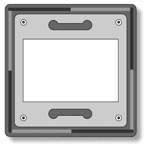Standard 35mm slide mounts have an aperture slightly smaller than the full frame of a 35mm transparency. Where cropping is required, it is possible to cut a suitable black or metal-foil mask to reveal only part of the image. However, it is important to work extremely accurately because when projected, and magnified many times, any errors in the alignment or shape of the mask will be all too apparent. The best result is generally obtained by positioning the mask aperture in the centre of the mount. If this is not done, masked images projected sequentially appear to move up and down on the screen.


Glassed slides have the obvious advantage of protection from dust, finger prints and physical damage, but in the long term suffer from the ingress of moisture and perhaps Newton's rings. Slides in standard plastic mounts probably have the longest life provided they are properly protected, and stored in an airy but dark and dry location.
Groups of transparencies are ideally presented in clear A4-size sheets that typically accept up to 24 mounted 35mm slides. Sheets of this type are available in flexible plastic suitable for ring binders, or as rigid journals that open like books. Both types offer considerable protection and can be placed on a light box for viewing.






